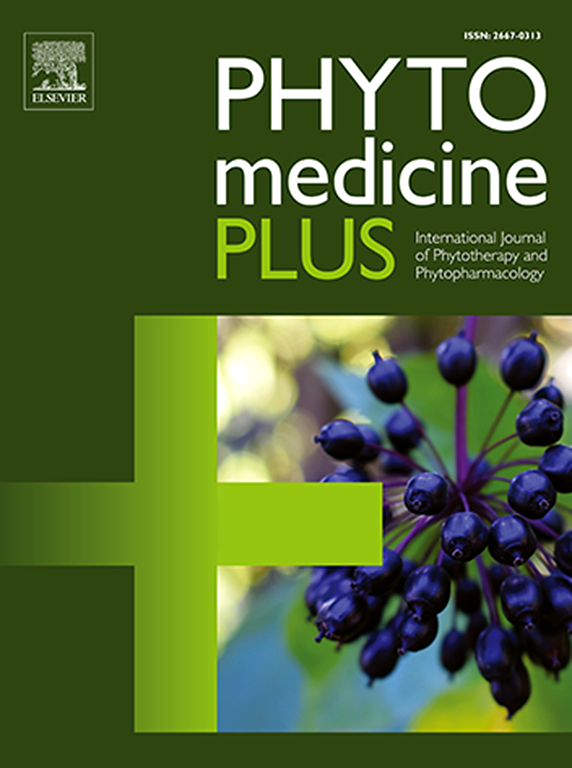细刺草(Pithecellobium dulce)甲醇和乙腈叶提取物的生物活性化合物表征、抗氧化和抑菌活性
Q3 Pharmacology, Toxicology and Pharmaceutics
引用次数: 0
摘要
在药用植物中可以发现许多具有不同药理特性的天然物质。蔷薇属(蔷薇属)豆科植物豆科植物是一种传统的药用植物。在许多国家,杜鹃花植物的各个部分传统上被用于治疗各种健康疾病。目的研究杜鹃叶甲醇提取物和乙腈提取物的植物化学性质,评价其抗氧化活性和抑菌活性。材料与方法采用气相色谱-质谱联用光谱(GCMS)和红外光谱(FTIR)对杜鹃叶甲醇和乙腈提取物进行了提取和表征。进一步的评价是为了了解甘露甘露的生物医学用途。测定了提取物对大肠杆菌、枯草芽孢杆菌和金黄色葡萄球菌的抑菌活性。采用DPPH法和过氧化氢清除法测定提取物的抗氧化活性,磷钼法测定提取物的总抗氧化活性。结果GC-MS共鉴定出23个化合物;其中5种与甲醇提取物有关,18种与乙腈提取物有关。初步鉴定乙腈叶提取物中存在的化合物为2-壬壬酸;戊烷、2、4-dimethyl -;lupeo;叶绿醇;丙炔酸;双环(2.2.1)和庚烷-5-(乙基-1-胺)。丙酰胺;N-methyl-2-amino -;乙烷、1 - chloro-1-fluoro;一氧化二氮;在甲醇提取物中发现了氧烷、(乙氧基甲基)-和2,5-环二烯-1-醇。FTIR分析鉴定了叶提取物中的各种官能团,表明存在醇类,酚类,不饱和和饱和碳氢化合物,胺,类黄酮和卤化化合物。乙腈和甲醇提取物具有显著的抗氧化和抗菌性能。甲醇和乙腈叶提取物对大肠杆菌(21±1.1 mm)和枯草芽孢杆菌(20.6±0.5 mm)的抑制作用最强。结论该植物中含有多种具有抗菌和抗氧化活性的植物化学物质。因此,杜鹃叶提取物可能具有显著的抑制人体感染的作用。本文章由计算机程序翻译,如有差异,请以英文原文为准。
Bioactive phytochemical compounds characterization, anti-oxidant and anti-microbial activity of the methanol and acetonitrile leaf extracts of Pithecellobium dulce
Background
Numerous natural substances with various pharmacological properties can be discovered in medicinal plants. Pithecellobium dulce (Roxb.) Benth is a traditional medicinal plant, belonging to the family Leguminosae. The various parts of the P. dulce plant are traditionally used to treat a wide range of health disorders in numerous countries.
Purpose
The aim of this investigation is to demonstrate the phytochemical profiling of methanol and acetonitrile leaf extracts of P. dulce and evaluate their antioxidant activity and antibacterial potential against pathogenic bacteria.
Materials and methods
The methanol and acetonitrile extracts of P. dulce leaf were extracted and characterized by using GCMS– and FTIR. Further evaluation was done for an understanding of the biomedical uses of P. dulce. The antibacterial activity of the extracts was monitored against Escherichia coli, Bacillus subtilis, and Staphylococcus aureus. The antioxidant activity of extracts was conducted by using DPPH and hydrogen peroxide scavenging activity, and total antioxidant activity was performed by phosphomolybdenum assay.
Results
A total of twenty-three compounds were tentatively identified through GC–MS; five of these were associated with the methanolic extracts, while eighteen were with the acetonitrile extract. The tentatively identified compounds present in acetonitrile leaf extract were 2-nonynoic acid; pentane, 2,4-dimethyl-; lupeo; phytol; propiolic acid; bicyclo(2.2.1), and heptane-5-(ethyl-1-amine). Propanamide; N-methyl-2-amino-; ethane, 1‑chloro-1-fluoro; nitrous oxide; oxirane, (ethoxymethyl)- and 2,5-cyclooctadien-1-ol were the compounds found in methanol extract. FTIR analysis identified various functional groups in the leaf extracts, indicating the presence of alcohols, phenols, unsaturated and saturated hydrocarbons, amines, flavonoids, and halogenated compounds. Acetonitrile and methanolic P. dulce leaf extracts exhibited significant antioxidant and antibacterial properties. Methanolic and acetonitrile leaf extracts exhibited the highest zone of inhibition against E. coli (21 ± 1.1 mm) and B. subtilis (20.6 ± 0.5 mm).
Conclusion
This study highlighted the presence of different phytochemicals that showed anti-bacterial and antioxidant activities. Therefore, P. dulce leaf extracts may play a significant role in inhibiting human infections.
求助全文
通过发布文献求助,成功后即可免费获取论文全文。
去求助
来源期刊

Phytomedicine Plus
Medicine-Complementary and Alternative Medicine
CiteScore
3.70
自引率
0.00%
发文量
178
审稿时长
81 days
期刊介绍:
 求助内容:
求助内容: 应助结果提醒方式:
应助结果提醒方式:


